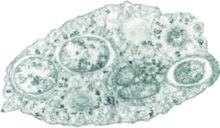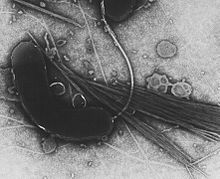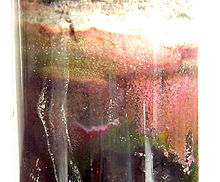Purple sulphur bacteria are the classification of the Proteobacteria type of the bacteria that are potential for photosynthesis.
Some of the purple sulphur bacteria examples are Spiribacter salinus, Chromatiaceae, Spiribacter roseus, Aquisalimonas halpphila, Aquisalimonas lutea, Spiribacter aquacticus, Spiribacter curvatus and Arhodomonas.
The purple bacteria examples are divided into three classes-
Alphaproteobacteria
The members of this group are diverse and have many in common yet nevertheless also share common ancestor. Just like the rest of the proteobacteria, they are by nature gram negative.
There are very few studies that actually refer to the genetic natural transformation in the few examples of alphaprobacteria and thus the process identified has been named and seen in Agrobacterium tumefaciens, Bradyrhizobium japonicum and the Methylobacterium organophilum.
Some of its own intracellular parasitic inclusions lack the peptidoglycan and are also in general gram variable. As a whole, the class includes protomitochondrion.

Betaproteobacteria
This class comprises of 400 different species in bacteria and 75 genera in them. In all, the Betaproteobacteria shows a good classification of all the metabolic process and occupies various environment from pathogen lying inside the host organism to the oligptrophic ecosystem.
Most of the Betaproteobacteria are heteroptrophic that derive the electrons and the carbon from the organocarbon sources. Some of them are photoheterotrophic deriving energy from carbon and light from all the organocarbon sources.
Rest are autotrophic that derive their carbon from all the bicarbonate and carbon dioxide with their electrons from the reduced inorganic ions like sulfhide, ammonium and nitrite with many also being chemolithoautotrophic.
Betaproteobacteria are mostly used as nitrate with being the electron acceptor and also can be used remove industrial waste by denitrification.

Gammaproteobacteria
This group contains 250 genera, that make it most rich in taxon and genera for the prokaryotes. It is quite in parallel with use in medical, ecological and important scientific groups.
It is made up of the all the gram negative microbes and is mostly physiological and phylogenetic diverse class in the Proteobacteria. They can mostly live in marine, terrestrial and play important roles that include the extreme surroundings like the hydrothermal vents.
The purple sulphur bacteria examples are the gram negative type that produce their own food via the process of photosynthesis and thus are phototrophic. They are high in pigment with the bacteriochlorophyll A and B along with several other carotenoids.
These shall be divided into two further groups- the purple non-sulphur and the purple sulphur. The purple bacteria are regarded to be anoxygenec phototrophs that are found in wide range in the nature but more are aquatic with anoxic state favoring pigment synthesis.

Where are the purple sulfur bacteria found?
The purple sulfur bacteria are usually found within the illuminated zones of the water or lakes regions that are anoxic.
These are the area where there is an accumulation of hydrogen sulphide or also in the sulfur springs where there is a production of hydrogen sulphide via biological process or geochemical. This triggers the formation of purple sulfur bacteria blooms.
The purple sulphur bacteria examples are mostly species that thrive in the soil, the rivers, mud area, moist, lakes, ponds, marine places and the sulphur spring. The green and purple bacteria are mostly and often seen in the region of mud, river and lakes
How do bacteria use sulfur?
Sulfur is an important to all organisms. It takes up sulfate from sea water, soil, algae and plant. It is used up to make one or more needed amino acids which are also used for protein making.
They are also used as co-enzymes. The sulfur usually produces slime and helps the rest bacteria like iron bacteria to grow. There are certain bacteria which are referred to as sulfur reducing bacteria which are capable of reducing sulfur to hydrogen sulfide.
These microbes use up the compounds of inorganic sulfur as accepting electrons that shall help in sustaining many activities like respiration, growth, stable energy during no presence of oxygen.
The sulfur is stored in the storage globules in bacteria and plays a central use in metabolism of certain anaerobic microorganism. The very prominent among all the rest are the bacteria that oxides sulfide from sulfide to sulfate.
Is purple sulfur bacteria autotrophic?
The autotrophic bacteria are the one that synthesize their own foo. They are seemed to perform certain actions that include the photons or the light sources or energy and the chemicals.
The given purple bacteria examples carry out several functions that help and allow them to get themselves adapted to various and even more conditions in the extreme surrounding. These are thus photoautotrophs and also called as chemoautotrophic and also photoheterotrophic.
This is in order to get the energy for the purpose of sustaining biologically. On considering this state, the make the use of inorganic compounds just like water, carbon dioxide, hydrogen sulfide and much more.
They are a very strong evidence if photoautotrophs and are widely spread with having a limitation in their capability to photo heterotrophy and also are poor to getting used to with the dark phase of growth and metabolism.

What is the purpose of purple sulfur bacteria?
The purple sulfur bacteria also termed as PSB are photosynthetic and get in work to reduce the carbon dioxide to carbs with suing up of no water.
They use up hydrogen sulfide and not water for easy work. On addition to this and related to growth factor, the purple sulfur bacteria have high concentration of sulfide and ammonia that helps in promoting of the growth.
They are able to contribute to the environment by taking part in the nutrient cycling and with the use of their metabolism to change the nearby. They play a role in primary production that suggests that these are able to affect carbon cycle via fixing carbon.
They also take part in phosphorous cycle and the iron cycle. With upwelling of all these there is a recycling of oxic layer of the ales which is given to the heterotrophic bacteria for the use. They also contribute to the place for the purpose of their growth.
Why does purple sulfur bacterium release elemental Sulphur?
Just like the rest algae, cyanobacteria or the plants, the purple sulfur bacteria are not seemed to use up water as the potential reducing agent and thus are not capable of producing oxygen.
The sulfur is in terms oxidized to make granules of the elemental sulfur which in turn gets to oxidize the formation of sulfuric acid. The sulfur bacteria are commonly in capacity to use up several sulfur compounds that are inorganic.
These elements include sulfite, thiosulfate, the elemental sulfur with in terms are sued up by the purple sulfur bacteria as a source of energy. Nevertheless the final product is always sulfate.
What are purple non Sulphur bacteria?
The purple non sulphur bacteria are commonly referred as PNSB and are phototrophic in nature. This gains lot of increasing attention in the production of plant.
The attention is for their capacity to gather and produced compounds of high value which are useful for their growth of plant. They can fix up carbon dioxide along with nitrogen. They are capable of breaking organic compounds as well. The sources of their energy are mostly the organic and inorganic elements and light. They can be found in dark and glowing areas which have no sulfide. They do no form blooms and thus have no high visible concentration.

FAQs-
What are Carotenoids?
Carotenoids are pigments that are synthesized by the bacteria, algae and plants. They are responsible to offer the bacteria the colour of red, brown, purple and orange.
What is Protomitochondrion?
These are the bacteria that had been engulfed by the entire ancestor being eukaryotic and had given rise of mitochondria which are the organelles inside the eukaryotic cells.
What is Hydrothermal vents?
These are the outcomes of the seawater percolating under via the fissures in the crust of the ocean with the vicinity in the subduction zones.
What is an example of purple non Sulphur bacteria?
An example of purple non Sulphur bacteria is Rhodopseudomonas palustris CGA009.
Also Read:
- Adenine vs thymine
- Nucleic acid monomer
- Diffusion in cell
- Do prokaryotes have histones
- Contractile vacuole in amoeba
- Chloroplast
- Contractile vacuole in euglena
- Do chloroplasts have a nucleus
- Independent assortment example
- Does mitochondria have double membrane
I am Ankita Chattopadhyay from Kharagpur. I have completed my B. Tech in Biotechnology from Amity University Kolkata. I am a Subject Matter Expert in Biotechnology. I have been keen in writing articles and also interested in Literature with having my writing published in a Biotech website and a book respectively. Along with these, I am also a Hodophile, a Cinephile and a foodie.